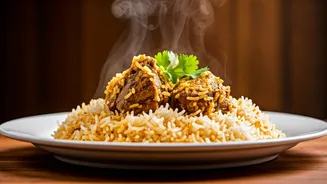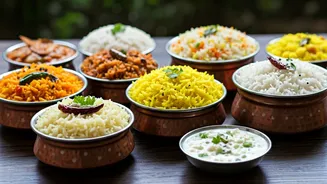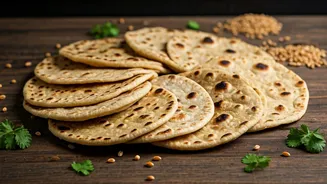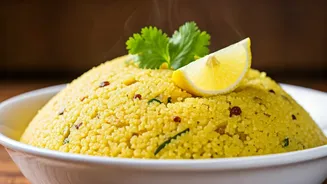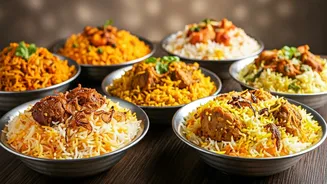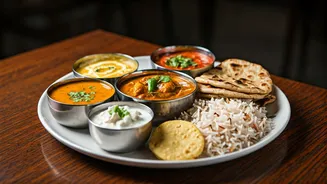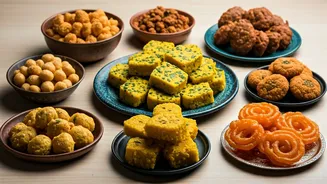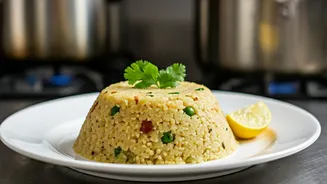Lemon Rice: Tangy Delight
Lemon rice, or 'chitranna,' is a vibrant and zesty dish, perfect for a light meal or a flavorful side. The foundation of this dish is cooked rice, which
is then seasoned with a tempering of mustard seeds, urad dal, chana dal, curry leaves, and green chilies. The bright yellow color and the tangy taste come from the generous addition of lemon juice. Often garnished with peanuts and fresh coriander, this dish is a quick, easy, and satisfying option. It’s also incredibly versatile, lending itself to modifications based on available ingredients and personal preferences. The crispness of the peanuts and the fragrance of the curry leaves beautifully complement the tartness of the lemon.
Tamarind Rice: Sour Sensation
Tamarind rice, known as 'puliyogare,' offers a distinctive sour and savory experience. The key ingredient is tamarind pulp, which gives the dish its characteristic tanginess. Cooked rice is mixed with a flavorful paste of tamarind, spices, and sometimes jaggery for a touch of sweetness. A tempering similar to that of lemon rice, with mustard seeds, urad dal, and curry leaves, enhances the taste and aroma. Often, red chilies are added for a spicy kick. Tamarind rice is a popular offering during festivals and special occasions, showcasing the rich culinary traditions of South India. Its ability to balance sour, sweet, and spicy elements makes it a beloved choice.
Curd Rice: Cooling Comfort
Curd rice, or 'daddojanam,' provides a cooling and soothing experience, making it an ideal dish for warm weather or to balance spicy foods. It is a simple combination of cooked rice and curd (yogurt). The dish is tempered with mustard seeds, green chilies, ginger, and curry leaves, which adds a refreshing flavor profile. It's often garnished with coriander leaves and sometimes with a sprinkle of pomegranate seeds. Curd rice is known for its digestive properties and is often served at the end of a meal to aid in digestion. It's a versatile dish that can be customized to suit individual tastes, ranging from plain to subtly spiced.
Coconut Rice: Creamy Texture
Coconut rice, or 'thengai sadam,' showcases the creamy and aromatic qualities of coconut. The rice is cooked with coconut milk, which infuses it with a rich, subtly sweet flavor. The tempering typically includes mustard seeds, urad dal, chana dal, curry leaves, and sometimes cashews for added texture and richness. Freshly grated coconut can be added as a garnish, amplifying the coconut flavor. Coconut rice pairs well with various vegetarian and non-vegetarian dishes. Its inherent mildness makes it a great canvas for other flavors, such as the spiciness of a curry or the tanginess of a chutney.
Tomato Rice: Tangy Treat
Tomato rice is a flavorful and colorful dish that combines the acidity of tomatoes with aromatic spices. It's made by cooking rice with a base of tomatoes, onions, garlic, and spices like turmeric, chili powder, and garam masala. The tomatoes provide a natural sweetness and tang. It can also include tempering with mustard seeds and curry leaves. Some recipes incorporate vegetables like carrots and peas to increase the nutritional value and texture. Tomato rice is a fulfilling meal on its own or it can be a great side dish that complements almost any South Indian meal. It’s a versatile and satisfying option for any time of the day.
Bisi Bele Bath: Hearty Mix
Bisi Bele Bath is a complex and flavorful rice dish that hails from Karnataka. It is a one-pot meal comprising rice, lentils, vegetables, and a special spice blend. The key to its unique taste is the Bisi Bele Bath powder, which is a blend of various spices, including coriander seeds, red chilies, and cinnamon. Vegetables such as carrots, beans, and potatoes are added to enhance the taste and nutritional value. The dish is known for its hearty and satisfying nature. Bisi Bele Bath offers a complete meal in one dish, combining the goodness of rice, lentils, vegetables, and aromatic spices.
Vegetable Biryani: Aromatic Blend
Vegetable Biryani is a fragrant and flavorful rice dish, popular across South India. Though biryani variations exist, this version uses rice (typically basmati) layered with vegetables, herbs, and spices. The key to a good biryani lies in the careful layering of ingredients, allowing the flavors to meld during the cooking process. Spices like saffron, cardamom, and cloves contribute to its rich aroma and complex flavors. Vegetables like potatoes, carrots, and peas are commonly used, alongside the use of mint and coriander leaves. The use of ghee enhances the flavor and adds to the dish's richness. This dish is usually served with raita, a yogurt-based side dish.
Chicken/Mutton Biryani: Meat Delight
Chicken or Mutton Biryani is a festive dish, celebrated for its rich flavors and enticing aroma. It involves marinated chicken or mutton, layered with fragrant basmati rice and a blend of spices. The meat is often marinated in yogurt and spices before being cooked, which tenderizes it and adds flavor. Saffron is frequently used to provide both color and an exquisite aroma. The dish can be cooked using the 'dum' method, where the ingredients are sealed in a pot and slow-cooked, allowing the flavors to meld. This process ensures that the rice is light and fluffy, and the meat is tender. This biryani is often garnished with fried onions, coriander leaves, and sometimes boiled eggs, making it a complete and satisfying meal.

